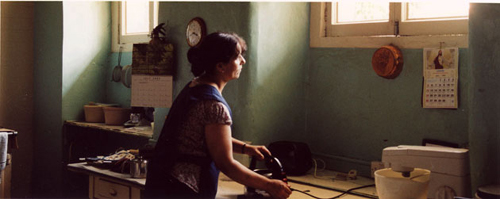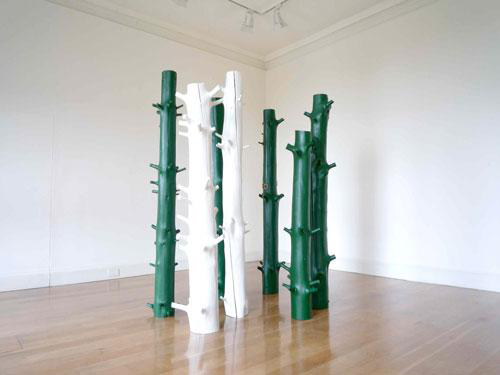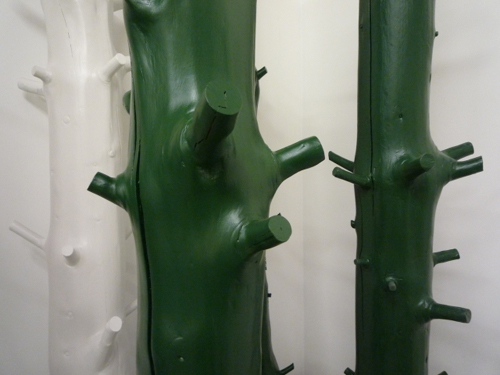

Edinburgh International Festival
7 August–27 September 2009
by THE EDITOR
The New Town as such does not contain a single exhibition within its sublime urban fabric, which is something of a loss. However the accommodation of one key element, Joseph Kosuth’s display of a set of illuminated interrogations between Charles Darwin and the later 19th century German philosopher, Friedrich Nietzsche set in the space where Darwin as a student began his earliest contemplations is ‘an Enlightenment’ which while very much a post-Enlightenment exercise is set up in an undoubted set of spaces that are true to the 18th century period itself, dramatically presented in the core University Library. This and the eight other exhibition or installation spaces remind us of Juliana Engberg’s curatorial skill: recently Leon van Schaik architect/impresario in Melbourne has referred to this particular bent as, “an exert[ing] of the auteurial power of a film director in the manner in which she assembles her shows”, in Melbourne at ACCA (Australian Centre for Contemporary Art) and else where. Confronted with the particular dispersal of the nine venues across the city, Engberg has orchestrated six individual exhibitions at the Dean Gallery with two separate venues, one for Kosuth at the University Library, and one further down towards the New Town, being at the Collective Gallery, while another project is dispersed across several venues.
The overall mood of The Enlightenments seems fortuitously perhaps, in this 21st century culture, to reflect the innate scepticism of the famous 18th century philosopher David Hume who grew his international reputation in Edinburgh. He was a vital constituent part of this Enlightenment. (So attached was he to the building of the New Town that on acquiring a plot there, he was crossing from the Old Town to inspect it when he fell into the intermediate bog and, had to be rescued by a ‘fish-wife’ but who first made this non-believer recite the Lord’s Prayer, which he duly did). Later he fought with other notables to prevent the city from building houses on the South Side of Princes Street, thus preserving the panorama. One can say that it is unfortunate that neither the buildings of the ‘sublime’ New Town, nor the Gardens that enhance the urban grace of the place, could host at least one of Engberg’s constituent projects, although the potential was there.
Hume was himself hostile to Christianity, as A.J. Ayer claimed, on both intellectual and moral grounds. He had been much influenced by Pierre Bayle’s, Dictionnaire historique et critique, and had thus entered the mainstream of Continental thinking. Not only did his scepticism grow, but he also took an ironic standpoint. After his period in Paris, he returned to Britain, taking with him for sanctuary the now seriously unpopular Jean-Jacques Rousseau. Perhaps regrettably, a place was found for him in England, when a direct settling in Edinburgh would surely have been better. It is necessary to describe some of this Enlightenment background, since this 2009 Festival series of exhibitions can be shown to link for the most part loosely but meaningfully to the main Enlightenment inspiration.
Joseph Kosuth’s exhibition is useful because it reflects the outcome of the Enlightenment and the extent to which the inclusion of Nietzsche creates something of an irrelevance. More relevant is the film at the Dean Gallery, Dread by Joshua Morley. He focuses on the thoughts of Jean-Jacques Rousseau and sets him in conversation with the Frenchman Blaise Pascal. (They never met in reality being of different periods). The film includes three creatures: a cow, a beetle and a ferocious dog named, ‘Dread’. The stage seems set for action between the two philosophers: but it seems more a discourse in the classical Greek manner than relevant to Edinburgh Enlightenment exchanges. Pascal was profoundly opposed to any revelation of God - apparent through the study of nature (hence the Mosley’s clay animals). Rousseau for his part denied the doctrine of original sin and depravity in humans; he believed in applying compassion, but in his view society always corrupted humanity. It seems that this tendency to exercise compassion, became embedded in Scots Law (as has been much evidenced to this day in prisoner release). Rousseau is however killed by the dog ‘Dread’, “seemingly asserting faith over reason,” as the catalogue claims. Morley’s fable has its place.
Elsewhere at this venue Tacita Dean’s film focuses on a group of five nuns in an Irish convent, surviving inmates of a much larger community. But it is the quality of ‘Light’ itself, which is expressed in its role of metaphysical and theological transformer. Although Newtonian in its scientific yet alchemical basis it activates the celluloid medium, and passing through glass allows the presentation of beautiful refractions. Dean brilliantly converts this scientific tool into an ethereal light that enlivens and reveals the hidden rooms and routines of the Order, recording the simple devotional lives, their internal contemplation and their external dedication, all of which defines the Presentation Sisters in their spiritual and earthly living. Dean has with this film appropriately defined metaphorically the real essence of ‘Enlightenment’. Dean now lives in Berlin but her own re-appraisal of Edinburgh would be valuable sometime soon.
From this perfectible world, another exhibition by Greg Creek at the Dean Gallery explores Chatter Shapes within Edinburgh, and correlates this City of the Enlightenment with the imagery of its shadowlands, its sleazy underside. In an epic drawing and watercolour frieze he creates a city panorama with a difference. Creek incorporates it into a loosely constructed topology here of dream-like faces and figures. He builds in Nelson Mandela with football superstar Zinedine Zidane (his image borrowed for a video film by Douglas Gordon at a previous Festival exhibition). Even the vegetation, unexpectedly exotic, creates singular botanical events. Greg Creek has shown himself in Australia to be both prolific and inventive. A previous 30-metre long unfurled scroll exhibited at ACCA in Melbourne in 2003 anticipated the mode and technique deployed here in Edinburgh, with great proficiency.
Still at the Dean Gallery, Nathan Coley’s sculptural installation of truncated trees takes as its inspiration the lodge porch supports found in the Highlands, knobbly and even with the stubs of branches. Coley has turned these elements into free -standing sculptures, painted dark green and occasionally white. Engberg too might have been able to use this work in an external display, say in Queen Street Gardens in the New Town, if only the ’keyholders’ in their comfort zone houses would concur. Artist Lee Mingwei presents here what he calls his Letter-Writing Project. Somewhat like ‘Facebook’ the purpose is to establish individual interaction between people, avoiding the perfunctory dismissiveness of electronic media. But these exhibitions are, The Enlightenments. Perhaps with more time for research Mingwei could have come up with equivalent models of 18th century exchanges of letters between Edinburgh inhabitants of the later 18th century. They all exist. A choice could have been made as to whether to cover grandees, or the doctors, lawyers and literati who thronged Edinburgh at that time. Or else the scrawls of the simpler but surprisingly literate, ordinary citizenry of that time. This kind of contextuality could have been given more of a chance.
Finally at the Dean Gallery, Gabrielle de Vietri (who has also exhibited at ACCA) has assembled a fascinating survey of childrens’ responses to direct quasi-philosophical questions. The immediate clarity of the answers, as shown in the video comes as impressive, compelling, yet innocent. It is also free of the inhibitions of Harry Potter’s world. After all, such questions as: “What is beauty?” tied no less than the Anglo-Irish philosopher Edmund Burke in knots. These young philosophers have no problem, so uncluttered is their thinking.
Juan Cruz added a further dimension to the series by creating 30 short texts and distributing them via ‘blue-tooth’ devices throughout the Festival venues. Entitled Mensch, the content is mildly disquieting, and ‘waspish’. It was thought that these mini-narratives would have been much the same as the 18th century stock exchanges among lawyers and professionals, in clubs and coffee houses of the time. But ‘Latte’ was not strong enough for that time. There is a satirical vein to Juan Cruz’s work, again relevant to the Enlightenment as was. Espresso it had to be.
In the work of Susan Norrie, both the video piece Enola which offers a space whereby assumed technologies of cinema can be questioned radically, and Shot, her other film, can be seen to advance this standpoint. Shot ponders Japanese research into space, and focuses on the 2009 satellite launch, Ibuki (meaning ‘breath, vigour and brighter future’). The satellite is designed to measure global greenhouse emissions and possibly to prevent extreme environmental and humanitarian catastrophe in developing countries in the future. Norrie was committed to documenting this event altruistically, perhaps with a measure of enlightened scepticism. Yet she also displays here that degree of rational optimism that Hume’s own disposition would have supported.
In the final analysis, one has to recognise in The Enlightenments, a degree of curatorial ingenuity, probably by coping with unforeseen problems of installation and assembly, far from Australia and Melbourne. Then one has to repeat the regret that the New Town of Edinburgh was not roped in for one installation, say that of Nathan Coley. And what of the linkages, the ‘inspiration’ from the real Enlightenment? One has to add that this whole enterprise, without mentioning David Hume, still seems to reflect his philosophy clearly. That relevant contextual link could have been made more self-evident. Or is it just ‘causality’, accidental and coincidental? Certainly it was implicitly Jonathan Mills, the Festival Director, who should be acknowledged for generating an effect, which he at least clearly wished for, and sought out.


